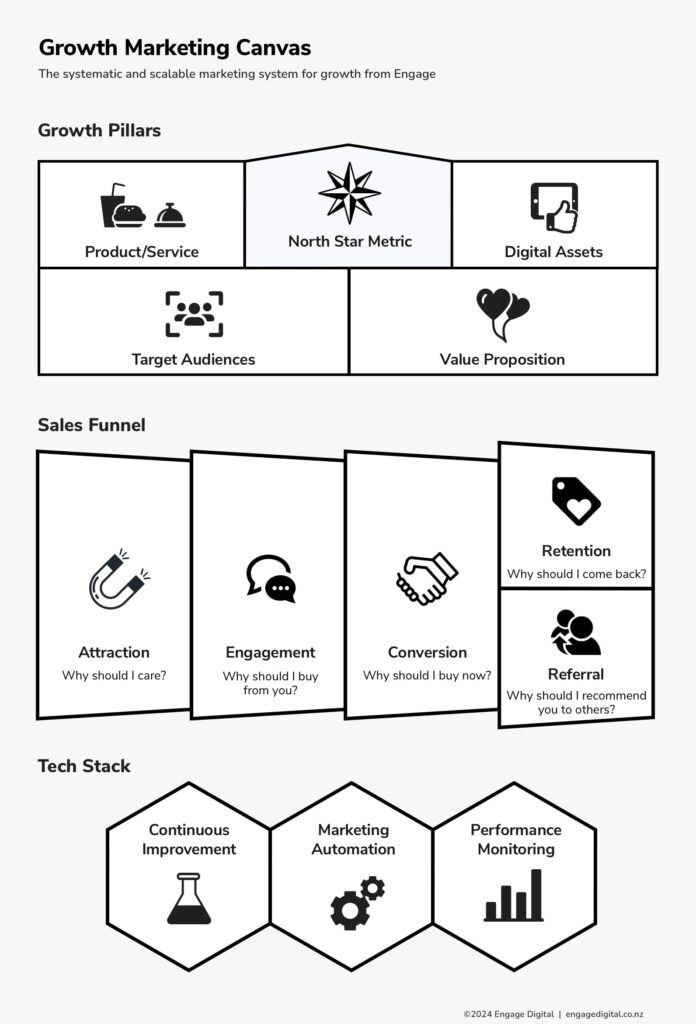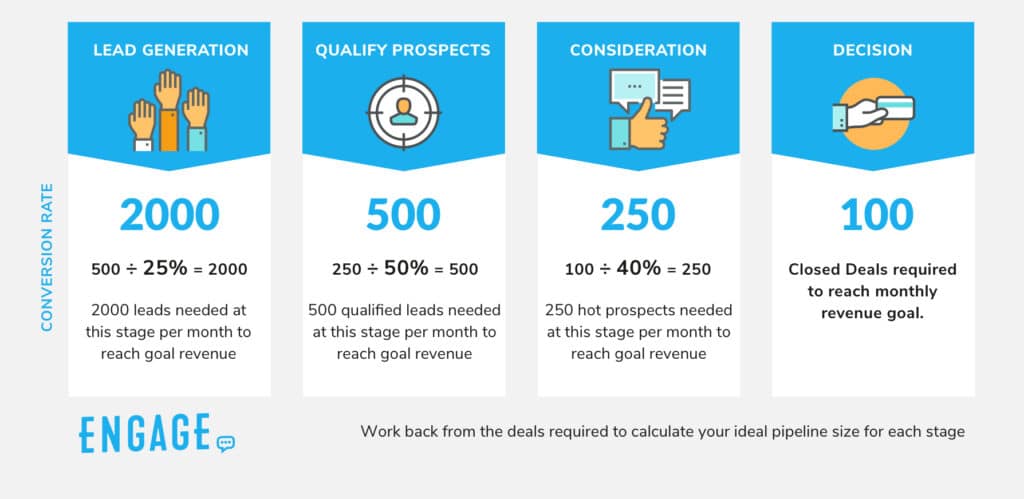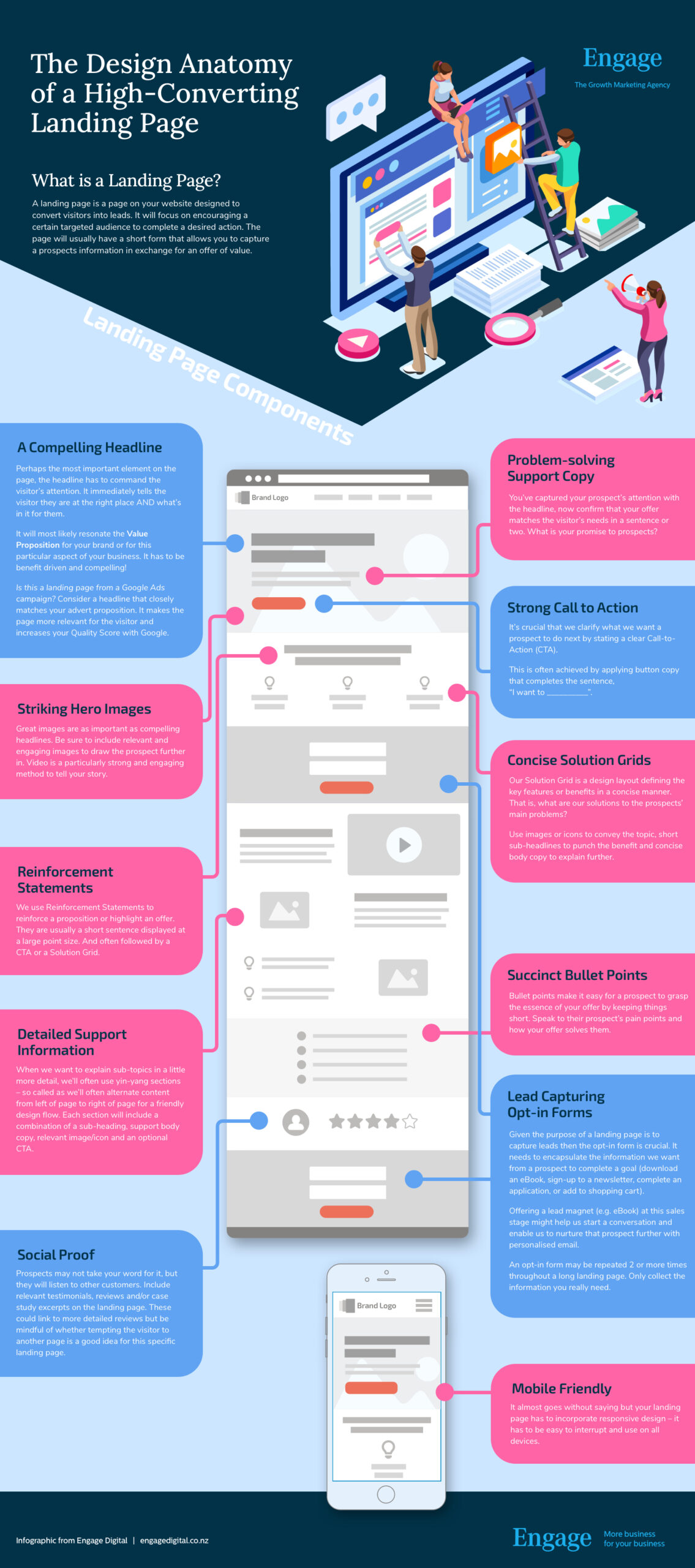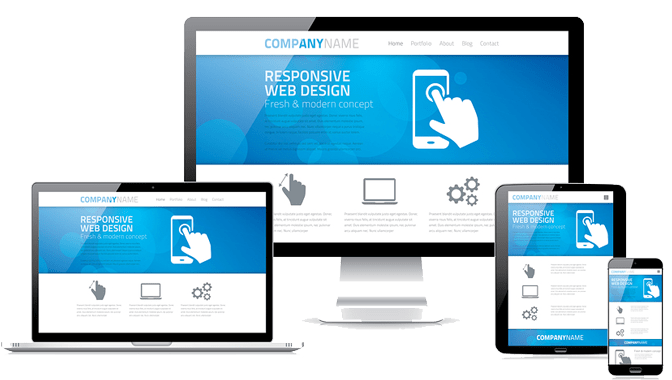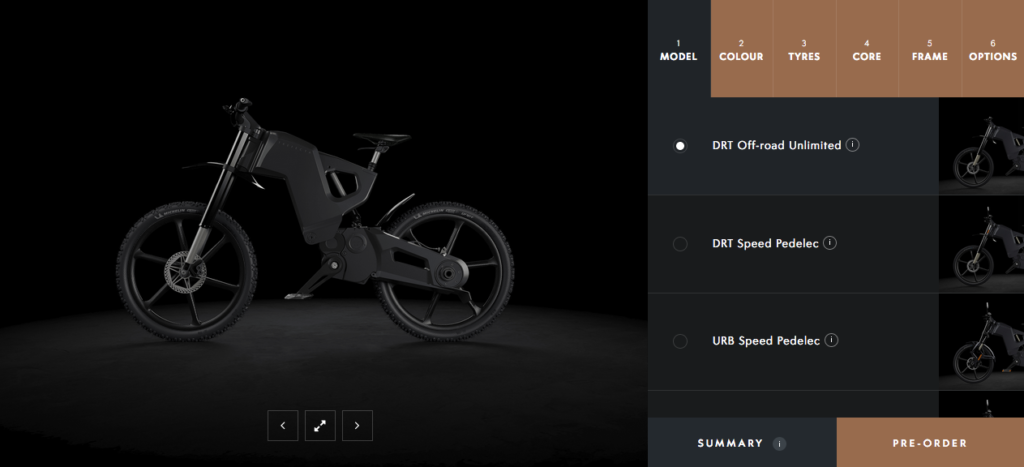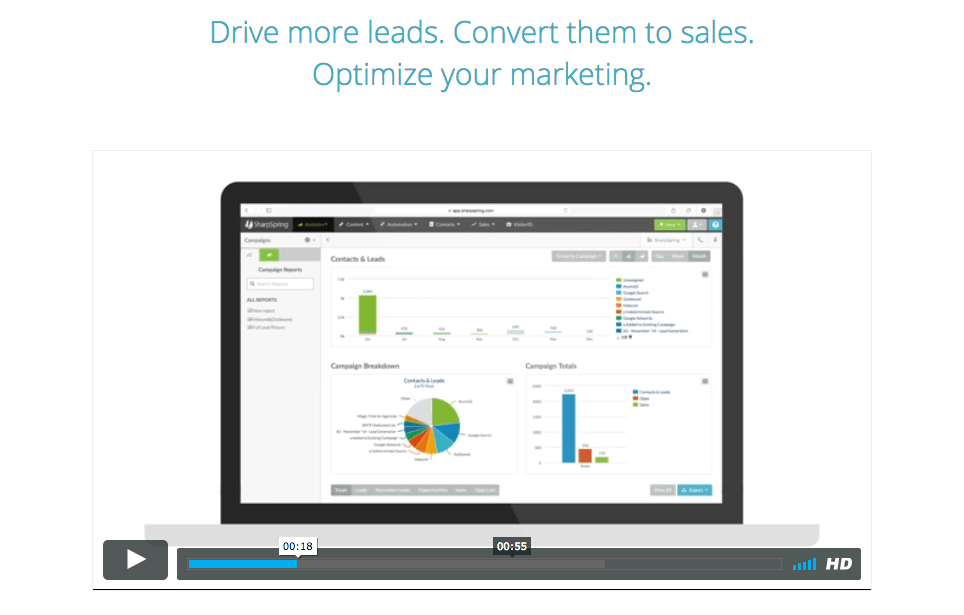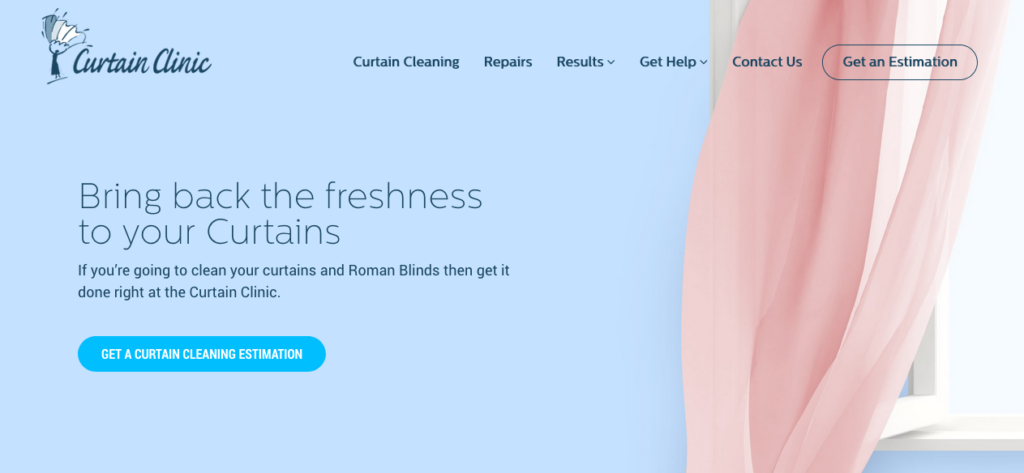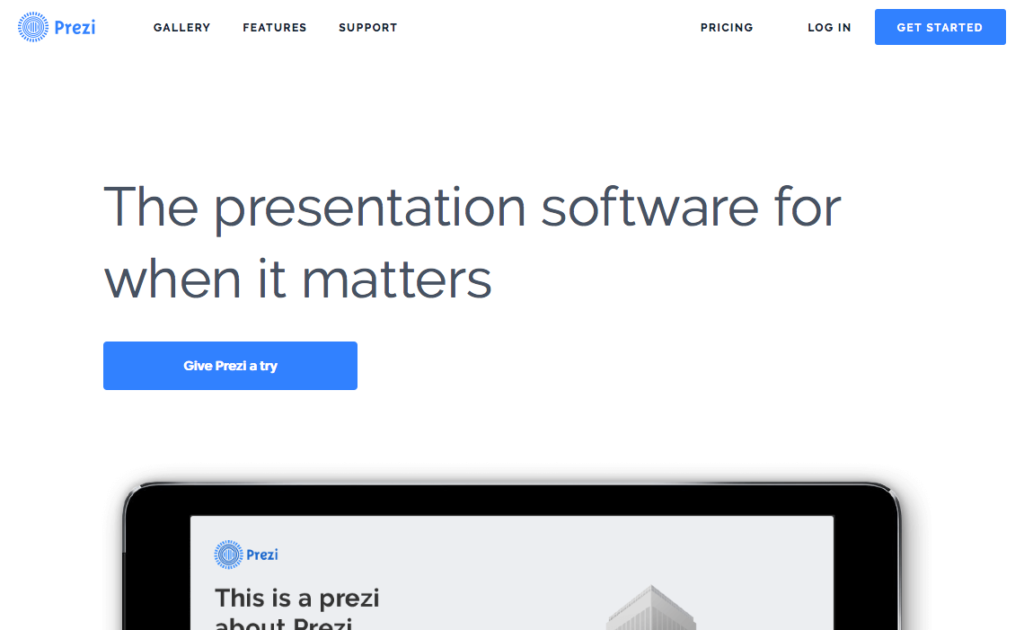Traditional marketing tactics are hitting their limits—especially for small and medium-sized New Zealand businesses aiming to achieve real, sustainable growth. In a digital environment where customer journeys twist across multiple channels and expectations shift by the week, simply “doing more” of what worked last year is no longer enough. Instead, growth-minded businesses are embracing a smarter, systematic approach: growth marketing.
Growth marketing flips the script by replacing guesswork with data and endless campaigns with purposeful experiments. Rather than pouring budget into a single channel or relying on gut instinct, it’s about methodically testing, measuring, and optimising every interaction across the customer lifecycle. The payoff? Faster returns, lower acquisition costs, and the agility to adapt as the market evolves—all while making the most of your marketing spend.
This practical guide lays out a step-by-step process for Kiwi businesses to plan, execute, and scale a growth marketing strategy that fits local conditions. You’ll discover how to audit your digital presence, set goals that align with business outcomes, prioritise high-impact marketing channels, and build a culture of continuous improvement. We’ll also cover the essentials of compliance with New Zealand’s Privacy Act 2020 and how to tap into government initiatives like the Digital Boost programme to accelerate your journey.
If you’re ready to move beyond business as usual and unlock the next level of growth, you’re in the right place. Let’s get started with the proven steps that will future-proof your marketing and drive measurable results.
1. Define Growth Marketing and Its Importance
Traditional marketing often centres on one-off campaigns—print ads, billboards, or a single social media push—hoping for that spike in attention. Growth marketing takes a different route. It treats every interaction with potential customers as an opportunity to learn, optimise and scale. Rather than betting big on a single tactic, it breaks down the entire customer journey into measurable stages, then runs rapid experiments to see what really moves the needle.
For a local example, picture a Wellington craft brewery that wants to increase online sales. Instead of merely boosting its Facebook posts, a growth marketing approach would test variations in email subject lines, tweak landing-page layouts for different audiences, measure repeat order rates and even set up a simple referral programme. The result? Faster customer acquisition, stronger retention, higher lifetime value and growth loops that feed on themselves—without dramatically raising the marketing budget.
What is Growth Marketing?
Growth marketing can be defined as a systematic process of testing and optimising tactics across the five key stages: acquisition, activation, retention, referral and revenue. Its hallmarks include:
- Cross-functional collaboration between marketing, sales and product teams
- An agile methodology, using short sprints and iterative testing
- Continuous data analysis to refine every step of the funnel
As Engage Digital puts it, “Growth marketing is about engaging more customers at every step of the sales funnel.” This philosophy ensures that no stage—from a first website visit to a fifth repeat purchase—is left to chance.
Four Core Growth Strategies to Guide Your Approach
A useful strategic lens for growth is Ansoff’s Matrix, which outlines four strategies:
- Market penetration: Increasing share of an existing product in current markets.
Risk vs reward: Low risk, modest gains.
Kiwi example: A Christchurch bakery ramps up its subscription-box deliveries within Canterbury. - Product development: Launching new products for existing markets.
Risk vs reward: Moderate risk, potential for strong rewards.
Kiwi example: A Tauranga fashion label introduces a sustainable activewear line for loyal customers. - Market development: Taking existing products into new territories.
Risk vs reward: Moderate risk, requires market research.
Kiwi example: A Dunedin software startup begins offering its solution to Australian SMEs. - Diversification: Entering entirely new markets with new products.
Risk vs reward: High risk, highest potential payoff.
Kiwi example: An Auckland e-commerce store opens a physical pop-up café to showcase its gourmet food range.
Comparing Growth Marketing with Digital and Performance Marketing
Digital marketing typically focuses on channel-centric tactics—SEO, content, social media—aiming for broad reach. Performance marketing drills down on paid channels like Google Ads or Facebook Ads, optimising for direct ROI metrics such as cost per click or cost per acquisition.
Growth marketing, by contrast, views the entire funnel as one cohesive system. It integrates paid and organic channels, experiments with cross-channel messaging and measures success at every customer touchpoint. Rather than simply driving clicks or impressions, growth marketing blends digital and performance tactics into a holistic framework that supports sustainable, scalable growth.
2. Audit Your Current Digital Marketing Efforts
Before you run any new experiments, it’s crucial to know exactly where you stand. A thorough audit not only uncovers quick wins—like a poorly performing landing page or an underused social channel—but also provides a solid foundation on which to build your growth marketing strategy. By establishing baseline metrics, you can measure progress and ensure every optimisation delivers real return.
An audit should be methodical yet agile, covering every digital touchpoint where potential customers interact with your brand. Think of it as a health check: you’re checking vital signs, identifying blockages and spotting areas that could accelerate growth with minimal effort.
Conduct a Comprehensive Marketing Audit
A well-rounded audit reviews performance across your main channels and pinpoints where you’re losing or winning ground. Key steps include:
- Website analytics
• Traffic sources, bounce rate, session duration - SEO health
• Site speed, technical errors, keyword rankings - Paid channels
• Google Ads quality score, cost per acquisition - Social media engagement
• Reach, impressions, click-through rates - Email marketing
• Open-rates, click-through rates, unsubscribe rates
Recommended tools: Google Analytics 4, SEMrush (or Ahrefs), Hotjar (for heatmaps) and native dashboards in Google Ads, Facebook Business Manager or LinkedIn Campaign Manager.
Here’s a simple audit checklist you can start filling in today:
| Channel | Metric | Current Value | Notes |
|---|---|---|---|
| Website (GA4) | Monthly sessions | 10,000 | Mobile bounce rate running at 60% |
| Organic search (SEO) | Top 10 ranking keywords | 15 | Few branded terms |
| Google Ads | Cost per acquisition (CPA) | NZ$25 | Quality Score 6/10 on main ad group |
| Facebook Page | Engagement rate | 2.3% | Posting frequency twice weekly |
| Email Newsletter | Average open rate | 18% | NZ SMB benchmark is 20–25% |
Perform a SWOT Analysis for Growth Opportunities
Once you’ve gathered channel metrics, use a SWOT framework to highlight where you can capitalise or need to shore up defences:
- Strengths: internal advantages such as a strong local brand presence.
- Weaknesses: gaps like low conversion rates on key landing pages.
- Opportunities: external trends to exploit, for example, emerging social platforms among Kiwi audiences.
- Threats: competitive or regulatory forces, such as a new entrant or upcoming privacy changes.
To make this actionable, sketch a simple 2×2 grid in your notes or slide deck. Label each quadrant and list two to three items under each heading. This exercise directs your focus toward high-impact experiments.
Leverage Engage Digital’s Audit Framework
At Engage Digital, our audit framework rests on three pillars: experimentation, agility and cross-department integration. By aligning marketing, sales and product teams around shared insights, we move swiftly from data to action. Discover how our growth marketing agency model helps Kiwi businesses accelerate results through structured audits and rapid testing.
3. Set Clear Goals and Key Performance Indicators (KPIs)
A robust growth marketing strategy starts with clear objectives and the right metrics to measure success. By linking your marketing goals directly to business outcomes, you ensure every campaign, channel and experiment contributes to the bottom line. In this section, you’ll learn how to align goals with wider company targets, define SMART KPIs and pick a single “North Star” metric to guide your team’s efforts.
Align Goals with Overall Business Objectives
Marketing doesn’t operate in a vacuum. When leadership sets a revenue target—say, “Generate NZ$60 000 in monthly sales by Q4”—your marketing goals must translate directly into that ambition. Start by breaking down high-level objectives into marketing-specific outcomes. For example:
• If the business needs 300 new customers per month, your acquisition goal might be “Acquire 90 new leads per week via digital channels.”
• If customer retention drives profitability, set a goal such as “Reduce churn from 8% to 5% within six months.”
These marketing targets should be developed in close consultation with sales, finance and product teams. Regular check-ins (weekly stand-ups or monthly strategy reviews) keep everyone on the same page and ensure your tactics support the overall growth roadmap.
Establish SMART KPIs
Once goals are aligned, it’s time to select KPIs that are Specific, Measurable, Achievable, Relevant and Time-bound. SMART KPIs remove ambiguity and make it straightforward to track progress. Below is a starter list of common growth metrics:
| KPI | Description | Example Target |
|---|---|---|
| Customer Acquisition Cost | Average spend to acquire one new customer | ≤ NZ$30 per acquisition |
| Lifetime Value (LTV) | Total revenue expected from a customer over their lifetime | ≥ NZ$450 per customer |
| Conversion Rate | Percentage of visitors who become leads or customers | 4% visitor → lead, 25% lead → sale |
| Retention Rate | Percentage of customers who make repeat purchases | Increase from 65% to 75% in 6 months |
| Churn Rate | Percentage of customers who stop using your product/service | Reduce from 8% to 5% annually |
By setting clear numerical targets and deadlines, your team can quickly identify when a campaign is underperforming—and pivot before budgets or momentum slip away.
Choose Your North Star Metric
A North Star metric is your single guiding light: the one measure that best reflects sustainable growth. Select a metric that:
- Correlates strongly with long-term business success.
- Is easy for your team to track and influence directly.
- Encourages behaviours aligned with your strategic priorities.
Examples:
- A SaaS company might choose Monthly Recurring Revenue (MRR)—it directly tracks subscription growth and stability.
- An e-commerce business may opt for Average Order Value (AOV)—increasing order size boosts revenue without extra acquisition spend.
- A content-driven site could focus on Engaged Sessions per User—higher engagement signals stronger interest, leading to better ad or subscription revenue.
Once you’ve chosen your North Star, centre team meetings, dashboards and experiment pipelines around it. Having one unambiguous measure keeps everyone focused on what really moves the needle—even as you run multiple tests across the funnel.
With aligned objectives, SMART KPIs and a clear North Star metric, you’re now equipped to measure performance, validate hypotheses and drive meaningful growth. In the next section, we’ll explore how to get to know your customers intimately and map out their entire journey.
4. Know Your Customers and Map Their Journey
Understanding your customers inside out is the cornerstone of any successful growth marketing strategy. When you grasp who your target audience is, what they care about and how they move through the buying process, you can craft messages and experiences that resonate at every touchpoint. In this section, we’ll explore how to combine qualitative insights with quantitative data to build buyer personas, map the customer journey and ultimately deliver personalised, timely interactions that drive growth.
Conduct Customer Research and Segmentation
Effective customer research blends direct feedback with behavioural data. Start by surveying existing customers and conducting one-on-one interviews to uncover their biggest challenges, decision criteria and preferred communication channels. Complement this with social listening—monitor mentions on Facebook groups, LinkedIn forums or local review sites—to see what people are saying about your brand and your competitors.
Next, use your web analytics platform to segment visitors by factors such as geography, referral source or on-site behaviour (e.g. pages viewed, time on site). These segments often reveal distinct groups—for example, price-sensitive bargain hunters versus brand-loyal repeat buyers—who warrant different approaches. Finally, merge these insights into detailed buyer personas, capturing:
- Demographics (age range, region, business role)
- Primary pain points and motivations
- Preferred research and purchase channels
- Decision-making criteria and budget constraints
With well-defined personas, your team can develop targeted campaigns—whether that’s a nurture email sequence for price-driven leads or an educational webinar for strategic decision-makers.
Map the Customer Journey Across Touchpoints
Once your personas are in place, map out the stages they move through—from first hearing about your brand to becoming an advocate. A simple journey map might include:
-
Awareness
- Typical behaviours: Searching online, reading blogs, scrolling social feeds
- Needs: Clear value proposition, social proof
- Engagement opportunities: SEO-optimised articles, targeted Facebook ads, short explainer videos
-
Consideration
- Typical behaviours: Comparing features, downloading guides, requesting demos
- Needs: Detailed information, reassurance of ROI
- Engagement opportunities: Case studies, comparison checklists, live chat support
-
Decision
- Typical behaviours: Checking pricing, reading reviews, finalising budget
- Needs: Clear pricing, incentives to act now
- Engagement opportunities: Limited-time offers, free trials, testimonial emails
-
Retention
- Typical behaviours: Reordering, logging into customer portals, attending training sessions
- Needs: Ongoing value, easy re-purchase processes
- Engagement opportunities: Loyalty programmes, automated reorder reminders, exclusive content
-
Advocacy
- Typical behaviours: Referring friends, leaving reviews, engaging on social media
- Needs: Recognition and rewards
- Engagement opportunities: Referral incentives, user-generated content campaigns, VIP webinars
By detailing behaviours, needs and engagement tactics at each stage, you ensure every interaction is relevant and nudges the customer closer to their next milestone.
Use Customer Data Platforms to Unify Insights
As businesses grow, customer data often fragments across web analytics, email platforms, CRM systems and third-party apps. A Customer Data Platform (CDP) solves this by aggregating data sources into a single customer profile. With a unified view, you can:
- Deliver consistent messaging across email, social ads and on-site content
- Automate personalised journeys (e.g. trigger a “welcome” email when someone visits your pricing page twice)
- Track customers across devices—an essential capability if your buyers switch between mobile apps and desktop sites
Implementing a CDP not only streamlines your data management but also unlocks advanced segmentation and real-time personalisation. The result is a seamless, one-to-one experience that deepens engagement, boosts conversion rates and encourages long-term loyalty.
5. Select and Prioritise Marketing Channels
With a clear picture of your current performance and your target customer journey mapped out, the next step is to choose which channels to invest in—and in what order. Rather than spreading your budget thinly across every possible tactic, focus on the few channels that promise the greatest impact. This ensures you’re not only efficient with spend but also able to deepen your understanding of what really moves the needle for your business.
Picking the right channels is both an art and a science. Use your audit data to identify where you already have momentum, then apply a simple framework to rank each option by conversion performance, audience reach and operating cost. Finally, weave those channels together in an omnichannel plan so your message is coherent and timely, no matter where customers encounter your brand.
Analyse Channel Performance Using Audit Data
Start by revisiting the metrics you collected during your marketing audit. Key data points to compare include:
- Conversion rate per channel (visitor → lead, lead → customer)
- Cost per acquisition (CPA) and overall spend
- Engagement metrics, such as click-through rate (CTR) and time on page
For example, you might find:
- Email campaigns boast a 5% click-through rate and NZ$18 CPA
- Organic search delivers 12 000 sessions per month with a 3% visitor-to-lead conversion
- Facebook Ads convert at 2.8% but incur a higher NZ$25 CPA
Organise these figures into a simple spreadsheet so you can see, at a glance, which channels are outperforming others. Colour-coding cells (green for top performers, grey for underachievers) can reveal quick insights into where to double down.
Prioritise Channels with the Highest ROI Potential
Once you have raw performance data, score each channel against three criteria:
- Conversion performance (higher is better)
- Audience volume (larger potential reach)
- Operating cost (lower CPA scores higher)
Assign a 1–3 score for each criterion, then sum these to get a prioritisation score. Here’s an example:
| Channel | Conversion Rate Score | Volume Score | Cost Score | Total |
|---|---|---|---|---|
| 3 | 2 | 3 | 8 | |
| Organic SEO | 2 | 3 | 2 | 7 |
| Facebook Ads | 1 | 1 | 1 | 3 |
| LinkedIn Ads | 2 | 1 | 2 | 5 |
In this matrix, email campaigns and SEO rank highest—so they become your priority channels. Facebook and LinkedIn can still play supporting roles, but allocate more budget and experimentation time to the top scorers.
Plan an Omnichannel Integration Strategy
Having chosen your primary channels, map out how they will interact throughout a campaign. An omnichannel strategy synchronises timing, messaging and creative assets so customers enjoy a seamless experience across email, social, search and retargeting.
Follow these steps:
- Define core campaign themes and key offers.
- Align creative assets (images, copy, landing pages) for each channel.
- Coordinate launch dates and frequency in a shared calendar.
- Set up cross-channel triggers—for instance, add site visitors from Google Ads into an email nurture sequence.
- Monitor interactions in real time and adjust budgets to amplify top-performing combinations.
Here’s a sample two-week campaign swimlane:
| Week | Social Media | Search Ads | Retargeting | |
|---|---|---|---|---|
| 1 | Welcome email to new leads | Teaser post with offer image | Brand-keyword ads live | — |
| 2 | Follow-up with case study | Customer testimonial video | Optimised ad copy A/B test | Retarget site abandoners |
By planning this way, each channel reinforces the others—building awareness, driving consideration and closing more sales. As you collect fresh data, refine your schedule and creative to further boost performance, and only then consider adding new channels to your mix.
6. Design and Run Growth Experiments
Growth marketing thrives on a relentless cycle of hypothesis, test and iteration. Rather than committing your entire budget to a single campaign, you’ll run a series of focused, small-batch experiments that validate assumptions quickly. This approach minimises risk, surfaces insights early and builds a team culture that values data over gut feel.
By breaking experiments into bite-sized sprints, you maintain momentum and can pivot fast when a test doesn’t deliver. Over time, these micro-wins compound—optimising email open rates, nailing the landing page layout or discovering the most effective ad copy. Each experiment not only improves your current funnel but also informs your next round of tests, creating a self-reinforcing cycle of growth.
Embrace an Experimental, Agile Mindset
Applying agile principles to marketing means organising work into short sprints—typically one to two weeks—where a small set of experiments is planned, executed and reviewed. Daily stand-ups keep the team aligned, while sprint retrospectives help surface lessons learned and plan for the next cycle. This structure keeps testing on track and ensures accountability without stifling creativity.
Formulate Hypotheses and Define Success Criteria
Every experiment starts with a clear hypothesis. Frame it as: “If we change X, then Y metric will improve by Z%.” For example: “If we shorten the email subject line to under 50 characters, our open rate will increase by 15%.”
Key elements of a well-defined experiment include:
- Control vs variant: define the unchanged (control) and changed (variant) versions
- Sample size: calculate the number of participants needed to reach statistical significance
- Measurement period: set a timeframe (e.g. two weeks) for collecting and analysing data
Execute Cross-Channel Experiments
Tactics can span multiple channels, each offering unique opportunities for growth:
- Email: A/B test different subject lines or send times to boost open and click-through rates
- Landing pages: run multivariate tests on headlines, images and call-to-action buttons to improve conversion rates
- Retargeting ads: swap ad copy and visuals to see which combination re-engages abandoned visitors most effectively
Track your experiments in a simple spreadsheet or project management tool. Include columns for hypothesis, channel, control metrics, variant performance and key takeaways. This living document becomes your single source of truth for what works (and what doesn’t).
To spark new test ideas, check out our 7 growth marketing ideas to boost your profits for practical tactics across channels.
Reference Engage Digital’s 10 Essentials Growth Formula
To accelerate experiments, leverage our structured 10 Essentials Growth Formula—a proven framework to boost sales by 30% in 90 days without extra ad spend. The video resource breaks down high-impact tactics such as conversion rate optimisation, audience segmentation and automated nurture sequences. Extract the sections on low-cost optimisations first to see results quickly, then layer in advanced techniques like dynamic content and cross-departmental workflows.
7. Implement Measurement and Analytics
Before you can steer your growth strategy, you need a clear, up-to-the-minute view of what’s happening at every stage. Solid measurement and analytics let you spot trends early, diagnose bottlenecks and prove the ROI of your experiments. By centralising data sources, tagging campaigns consistently and building dashboards that refresh in real time, you’ll spend less time wrangling spreadsheets and more time optimising what actually moves the needle.
Set Up Your Analytics Stack
An effective analytics stack usually includes:
- Google Analytics 4 (GA4) to capture website engagement, user paths and campaign conversions.
- CRM integration (Salesforce, HubSpot) to tie marketing leads directly to sales outcomes.
- Marketing automation reporting (Mailchimp, ActiveCampaign) for email open rates, click-throughs and workflow performance.
Consistent UTM tagging is non-negotiable. Append ?utm_source=, utm_medium= and utm_campaign= parameters to every outbound link. Adopt a standard naming convention (lowercase, hyphens instead of spaces) so summer-sale-2025 in your spreadsheet looks the same in your reports. Tip: keep your UTM glossary in a shared document—new team members will thank you.
Build Real-Time Reporting Dashboards
Rather than jumping between platforms, pull live metrics into a single dashboard. Tools like Looker Studio or your CRM’s native reporting can display:
- Acquisition overview: Sessions, new users and leads by source/medium.
- Funnel progression: Conversion rates at each stage—visitor → lead → customer—so drop-off points are instantly obvious.
- Experiment performance: A/B test results with confidence intervals and date filters to track statistical significance.
Lay these panels out on one screen and grant access to key stakeholders. A quick glance will tell you if traffic has dipped, a cohort is underperforming or an experiment needs a tweak.
Perform Cohort and Funnel Analysis
Snapshot metrics can be misleading—cohort analysis shows you how groups of users behave over time. Segment customers by signup month, campaign or device type to compare retention rates and purchase frequency. For instance, you might find April’s email campaign drives stronger Week 3 engagement than May’s.
Funnel analysis, on the other hand, visualises a defined path (e.g. landing page view → demo request → purchase) and highlights exactly where prospects fall away. Seeing percentage and absolute numbers side by side makes it easy to pinpoint whether your call-to-action needs clearer copy or your pricing page requires a redesign.
By combining cohort trends with funnel drop-off insights, you’ll know precisely which experiments to back. Over time, these data-driven tweaks will turn more first-time visitors into repeat customers—without guesswork.
8. Optimise Based on Data Insights
Data collection is only half the battle. The real value comes from turning insights into action—refining your campaigns, nailing down what works and leaving underperforming tactics behind. In this section, we’ll walk through how to interpret your results, iterate intelligently and make sure every lesson is captured so your team builds on past successes.
Identify Winning Variations and Tactics
Before you scale a change, confirm it’s truly driving performance. Statistical significance tells you whether a lift in metrics (open rate, click-through, conversion) is likely real or just random fluctuation. Aim for at least 95% confidence when comparing a control against a variant.
• Calculate significance with an online A/B calculator (e.g. Evan Miller’s tool) or within platforms like Google Optimize or Optimizely.
• Check your sample size against the minimum required to detect your target lift—many calculators will flag if you need more traffic or a longer test window.
• Focus on the metrics that tie back to your North Star. If your main goal is average order value, a subject-line test that boosts click-through but not revenue isn’t a “win.”
By locking in on meaningful lifts and ignoring vanity metrics, you ensure every optimisation moves the business forward.
Iterate Campaign Elements for Continuous Improvement
Optimisation is a cycle, not a one-off project. Follow this four-step process to keep momentum:
- Review experiment data. Look beyond overall lift—segment by device, location or time of day to spot hidden patterns.
- Extract lessons learned. Document what worked (and why). Did a shorter headline appeal more to mobile users? Was the new landing-page image more compelling to first-time visitors?
- Implement incremental changes. Rather than overhauling your entire funnel, tweak one element at a time—headline, offer, button colour—so you can isolate impact.
- Launch the next test. Use insights from prior rounds to inform fresh hypotheses. Over successive sprints, you’ll build a compounding effect of small wins.
Lather, rinse, repeat: this agile approach keeps your tactics responsive to new data and evolving customer behaviour.
Document and Share Best Practices
When experiments succeed (or fail), make sure everyone benefits. Set up a central “growth playbook” or knowledge repository—this could be a shared Google Drive folder, a Notion workspace or a section in your CRM. Include:
- Experiment brief: hypothesis, timeline, target metric, sample size
- Results summary: before-and-after data, statistical confidence, key takeaways
- Next steps: follow-up tests, rollout plan, stakeholders responsible
Regularly review and prune this library so it stays relevant. New team members can ramp up faster, and stakeholders see the evolution of your approach. Over time, this becomes your single source of truth for what drives growth—no need to reinvent the wheel every quarter.
By embedding optimisation into your rhythms, you shift from random acts of marketing to a disciplined, data-driven engine of continuous improvement.
9. Scale Successful Tactics Systematically
Once you’ve validated which experiments move the needle, it’s time to transition from ad-hoc tests to a repeatable, scaled process. Systematic scaling means formalising what works, aligning budgets and resources, and automating routine tasks so your team can focus on strategy, not busy work.
Formalise Your Growth Playbook
A growth playbook captures the blueprint for your scaled tactics. At minimum, include:
- Strategy overview: Objectives, North Star metric and guiding principles.
- Roles and responsibilities: Who owns each stage of the funnel—from campaign launch to performance review.
- Standard operating procedures (SOPs): Step-by-step guides for running common activities (email sends, A/B tests, ad optimisations).
- Reporting cadence: Frequency, audience and format for performance updates (daily dashboards, weekly stand-ups, monthly deep dives).
Having these sections documented ensures consistency as you bring more people on board or hand off tasks between teams.
Allocate Resources and Budget for Scale
Scaling successful tactics requires shifting from small pilot budgets to larger investments—while still setting aside funds to explore new ideas. A simple framework looks like this:
| Phase | Budget Focus | Typical Allocation |
|---|---|---|
| Pilot | Test new ideas | 10–20% |
| Scale | Amplify winners | 60–70% |
| Instrumentation | Analytics & tools | 10–20% |
Start by defining a pilot budget for all new experiments. Once a tactic proves its value, move it into your scale budget. Finally, reserve instrumentation spend on analytics, data integrations and A/B-testing platforms to maintain visibility as you grow.
Staffing decisions should follow a similar logic. Keep a lean core team in-house to own strategy and critical workflows, then tap specialised agencies or freelancers for burst capacity—whether that’s copywriting, design or paid-media management.
Automate and Streamline Repetitive Tasks
Automation frees up capacity and reduces the risk of human error. Identify high-volume, low-complexity tasks and apply tools accordingly. Common opportunities include:
- Drip email sequences (welcome series, cart-abandonment reminders)
- Lead scoring and routing (auto-assign high-value leads to sales)
- Paid-media bid optimisation (rules-based budget shifts in Google Ads or Facebook)
- Reporting and alerts (automated dashboard exports, threshold notifications)
Mini-checklist for automation readiness:
- Do you run the same sequence of emails for every new subscriber?
- Are low-value leads wasting sales time?
- Can campaign budgets adjust automatically based on performance?
- Is your team spending hours each week exporting and formatting reports?
For each “yes,” map out the tool and workflow that can handle it. Over time, you’ll free your team to focus on high-impact strategy and creative work—while your best tactics run smoothly in the background.
10. Ensure Compliance with Data Privacy Regulations
Maintaining customer trust is critical—and in New Zealand, that means adhering closely to the Privacy Act 2020. Treating personal data with respect is non-negotiable for your brand’s reputation and helps you avoid fines or reputational damage. By embedding privacy compliance into every stage of your growth marketing process, you reassure customers you value their information and use it responsibly.
Understand New Zealand’s Privacy Principles
The Privacy Act 2020 establishes clear rules for how organisations collect, use and store personal data. Key principles include:
- Purpose limitation: collect data only for a specific, lawful purpose.
- Transparency: inform customers why you need their information and how it will be used.
- Data minimisation: only hold the minimum data required for your marketing experiments.
- Accuracy: keep records up to date and correct any inaccuracies promptly.
- Security safeguards: protect personal data with appropriate technical and organisational measures.
- Restriction on disclosure: only share data with third parties if customers have given consent or if the law allows.
- Accountability: maintain clear records of data-handling practices and who is responsible.
For full details, refer to the Privacy Act 2020 Privacy Principles.
Implement Consent Management Best Practices
Consent isn’t just a one-off click—it’s an ongoing commitment. To manage consent effectively:
- Deploy a clear cookie banner that explains what cookies do, offers “Accept All” or “Manage Settings” options, and logs consent choices.
- Include concise, jargon-free privacy notices on forms and landing pages, for example: “By submitting this form, you agree to receive emails from [Your Company] and can opt out at any time.”
- Maintain a consent log with timestamps and the specific permissions granted, ensuring you can demonstrate lawful data collection if audited.
- Provide easy-to-find links to your full privacy policy, and remind customers how to withdraw consent or update their preferences.
Secure Data Storage and Limit Data Use
Strong data security underpins privacy compliance. Make sure to:
- Encrypt personal data both at rest and in transit, using recognised standards such as AES-256.
- Implement strict access controls, granting permissions on a need-to-know basis and auditing access logs regularly.
- Conduct periodic security audits and vulnerability assessments to identify and address potential risks.
- Adopt data minimisation: if an experiment only requires email addresses, avoid collecting additional personal details.
- Retain data only as long as necessary—set clear retention schedules and securely delete or anonymise records once they’re no longer needed.
By weaving privacy compliance into your growth marketing strategy, you safeguard customer trust, reduce legal risk and create a stronger foundation for long-term growth.
11. Leverage Government Support and Resources
Small businesses in New Zealand have a unique advantage: there’s a wealth of free and subsidised programmes designed to fast-track digital growth. By tapping into these resources, you can stretch your marketing budget, access expert advice and fill capability gaps without reinventing the wheel. Below, we’ll introduce the Digital Boost initiative, outline how to secure grants and training, and show you how to fold these insights into your growth roadmap.
Explore the Digital Boost Programme
The Digital Boost programme, run by Te Puni Kōkiri and MBIE, offers a suite of resources tailored specifically for Kiwi SMBs. It’s built around three pillars:
- Educate – free workshops and online courses to sharpen digital skills, from basic website fundamentals through to advanced marketing analytics.
- Checkable – a no-cost diagnostic tool that benchmarks your online presence against local competitors, identifying quick-win improvements in areas like mobile usability or page-speed.
- Spotlight Series – real-world case studies showcasing how other New Zealand businesses have transformed their operations with simple digital tweaks.
You can explore all the details and sign up for workshops at the official MBIE Digital Boost page: https://www.mbie.govt.nz/business-and-employment/business/support-for-business/digital-boost
Seek Grants, Training, and Advisory Services
Beyond Digital Boost, there are several government-backed grants and advisory programmes to help you advance:
-
Regional Business Partner Network
Eligibility: businesses with fewer than 50 staff.
Benefits: subsidised one-on-one advice, co-funded capability vouchers (up to 50% subsidy on eligible services).
Timeline: vouchers often approved within two weeks; advisory sessions scheduled shortly afterwards. -
Callaghan Innovation R&D Grants
Eligibility: companies investing in new product or process development.
Benefits: project grants covering up to 40% of qualifying R&D expenses.
Timeline: applications take around four to six weeks to assess. -
NZTE Capability Development
Eligibility: exporters looking to grow overseas.
Benefits: vouchers for up to 50% off services in areas like digital marketing, logistics and market research.
Timeline: approval within three weeks, based on a one-page application form.
Start by visiting the respective programme websites, checking eligibility criteria, then submitting your application. Keep a simple project plan handy—most schemes require a brief description of intended outcomes, budgets and timelines.
Integrate Digital Boost Insights into Your Plan
Once you’ve completed a Digital Boost diagnostic or attended a workshop, weave those findings directly into your growth marketing roadmap. For example, if your diagnostic flags slow page-load times as a barrier to conversion, prioritise a site-speed audit and optimisation in your next sprint. Or, if a workshop highlights the power of email automation, map out a simple drip sequence for cart-abandonment reminders and use your Regional Business Partner vouchers to bring in a specialist for setup.
By treating these government programmes as a strategic input—rather than an afterthought—you not only save on consultancy fees but also build internal capability. Over time, this approach embeds a continuous-learning mindset, ensuring your growth marketing remains adaptive, cost-effective and firmly rooted in local support networks.
Putting Your Growth Marketing Strategy into Action
Growth marketing offers a clear path from hypothesis to results, and the 11 steps we’ve covered form a complete blueprint: define your growth marketing approach, audit your current efforts, set SMART goals and KPIs, get to know your customers inside out, choose and prioritise channels, design and run targeted experiments, build a robust measurement framework, optimise based on insights, scale your wins, stay compliant under the Privacy Act 2020, and leverage government programmes like Digital Boost. Each step builds on the last, creating a continuous loop of learning and improvement.
Ready to get started? Begin with Step 1 by defining what growth marketing means for your business, then work through each stage methodically—auditing your efforts, mapping your customer journeys, testing new ideas and refining what works. This structured approach keeps your team focused on high-impact activities and ensures every tactic contributes to sustainable growth.
If you’d like to fast-track your results or tap into specialist expertise, Engage Digital is here to help. Visit our homepage to explore how our performance-driven growth marketing partnerships can accelerate your business: https://engagedigital.co.nz. Let’s build your next chapter of growth together.

